COMPLETE SET OF 4 PLATES
AN ELECTION ENTERTAINMENT
also know as FOUR PRINTS ON AN ELECTION
also known as
(scroll down further for individual plates available) |
This progress, Hogarth's last, is based on the disorderly, riotous Oxfordshire election of 1754 in which the Duke of Marlborough, a Whig ("the New Interest"), challenged the entrenched Tories ("the Old Interest") in the established stronghold of the latter party. Like "Southwark Fair," however, this work is not concerned with a specific event but aims to present a generalized picture of a violent, chaotic election.
Aimed at the upper middle and upper classes, this series shows the cynicism of the aristocratic class toward electoral politics and delineates their attempted manipulation of the populace. It depicts politicians of both parties using slogans, flattery, bribery, alcohol, food and trinkets to expoit the population in the interests of their own undemocratic ambitions. It exposes both parties as exciting the most degrading proclivities of the least able sections of the electorate (the poor, the simpleminded, the maimed, the dying) to produce a violence and an anarchy that ultimately envelops all and threatens the very ambitions they sought to satisfy.
[Excerpts this page are from Engravings by Hogarth, edited by Sean Shesgreen (Dover, 1973).]
|
| |

(click image to enlarge — Darvill's electronic watermark does not appear on actual engraving)
An Election Entertainment
Plate I
Painted and Engraved by William Hogarth
(Heath edition, 1822)
Sheet size: approx. 25 1/4 inches x 19 1/4 inches
Plate size: approx. 21 3/16 x 15 7/16
Condition: GOOD TO VERY GOOD; Nice dark impression; there is a stabilized tear in upper left corner and into image area (not very noticeable once mounted/framed; some foxing in margins.
[For sale in a complete set of 4 full page engravings, see below for details]
AN ELECTION ENTERTAINMENT (PLATE I)
This crowded print depicts the drunkeness, gluttony, violence, bribery and deception that occur at an alcoholic political banquet. The feast takes place in an inn decorated with a picture of William III (slashed by the celebrating Whigs); next to it hangs a politician's coat of arms showing three guineas and the words "Speak and Have." A bellowing mouth surmounts the emblem.
At the head of the table sits one of the two Whig candidates for Parliament. His name, according to the rectangular petition being given him, is Sir Commodity Taxem. This precious beau endures with a patient smile the kiss of a fat, toothless woman whose face is pushed into his. The prankster who holds these two together burns the politician's wig with his piple. The victim puts his arm as far around the stout woman as it will go. A little girl steals the ring from his finger. The party flag "Liberty and Loyalty" hangs above them. Next to them the second politician is beset by two drunks; the first, whose face bears four scratch marks, oppresses the man with his talk and blinds him with his pipe smoke; the second plays lustfully with his hand. Behind them two men vie for a lady's favors.
Further down the table sits a prodigiously fat clergyman surrounded by food and good drink—the bottle next to him is marked "Champagne." Next to him a convivial old man has drawn the fiddler from the band by means of a drink. Behind them a Scot remonstrates with the idle musician and scratches himself. At the second table three simpleminded figures share a bottle of "Burgundy" while one of them makes faces on a kerchief. A cripple in acute but undefined distress sits next to him. At the end of the table the mayor, slumped back in his grand chair, is being bled unseccessfully; he has passed out, perhaps died, from overeating; an oyster remains on his fork.
Directly behind him an election agent attempts to bribe a Methodist tailor who stand in the pose of a saint. The tailor's wife tries to persuade him with her fist, and his son supports her by pointing to the toes which peer through his shoe. A brick has struck another election agent as he enters the names in his ledger under "Sure Votes" or "Doubtfull." His fall has overturned the table behind him and spilled food on the floor. Next to a lobster (which appears about to eat a pork chop) lie a box of pipes and some tobacco ("Kirtons Best"); the "Act against Bribery and Cor[ruption]" has, appropriately enough, been made into spills.
In the center of the foreground sit two thugs returned from battle; the broken club of one lies on the floor next to a captured Tory sign "Give us our Eleven Days." [In 1752 England adopted the Gregorian Calendar and eleven days were omitted in September.] The rough butcher (wearing the Latin dictum "Pro Patria" on his hat) pours gin into the head wound of his companion, who drinks the liqour as an anesthetic. To the amazement of the boy who fills up a tub of punch, the man's head accepts the liquid as if it were empty. An unhappy Quaker who has come to sell election insignia looks at a credit note reading "April 1 1754 I promise to Pay to Abel Squat the Sum of Fifty pounds Six m[o]nths after date Value Re[cei]ved Rich Slim." At the door a hand-to-hand combat of uncertain cause takes place.
Outside a Tory procession passes by, bearing the party platform slogans "Liberty and Property," "Marry and Multiply in Spite of the Devil" and "No Jews" on an effigy of a Jew. The Tories throw rocks in through the window. One Whig empties a chamber pot on the mob, and another prepares to throw a stool out the window.
|
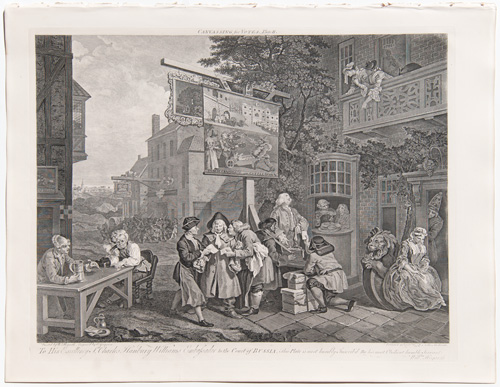
(click image to enlarge — Darvill's electronic watermark does not appear on actual engraving)
Canvassing for Votes
Plate II
Painted by William Hogarth and Engraved by G. Grignion
(Heath edition, 1822)
Sheet size: approx. 25 1/4 inches x 19 1/4 inches
Plate size: approx. 21 1/8 x 15 13/16
Condition: VERY GOOD TO EXCELLELENT ; Nice dark impression; short stabilized tear in upper left margin well away from image area; some typical light foxing in margins.
[For sale in a complete set of 4 full page engravings, see below for details]
CANVASSING FOR VOTES (PLATE II)
"Canvassing for Votes" illustrates the continuing violence, deception and bribery practiced, of course, in equal measure by both parties; this time the scene is out-of-doors. On the right stands the Royal Oak; its sign depicts Charles II's head with three crowns around it; two Parliamentarian horsemen search for him. This inn, the Tory headquarters, displays a broadcloth satirizing the Whigs entitled "Punch Candidate for Guzzledown." The top part shows money pouring out of the British treasury for bribes, and depicts a coachman's head being knocked off by William Kent's impractically low arch on the Horse Guards building with its comic beer-barrel clock tower. The second part of the cloth shows the Whig candidate as Punch shoveling money indiscriminately from two bags marked "9000" and "7000."
Below Punch stands the local Tory candidate; he buys trinkets from a peddler for two girls, one coy, the other forward. At the inn door a soldier observes the attractive mistress of the house as she counts her "take"; she sits on a British lion that devours a French lily (early states show the lion with a powerful set of teeth). In the inn's bay window (which bears the mark of political violence in its broken pane) one man eats a whole bird with his hands while another fills his mouth from a steak twice his size. A porter has delivered two parcels to the candidate, one marked "Punch's Theatre, Roy[al] Oak Yar," the other "Sr Your Vote and Interest." On bended knee, the messenger offers the politician a letter addressed "To Tim Partitool Esq."
A Tory mob besieges the Whig headquarters, an inn with a crown as its sign and the words "The Excise Office" inscribed on it. One man saws off the sign, unaware that he will fall with it; two others help him bring it down with a rope tied to its support. Someone fires point blank into the crowd from a second floor window.
Outside the third inn called the "[Por]tobello" in honor of a famous British naval victory over the French, a barber and a cobbler reenact the battle. The drunken barber, whose jug, basin and cloth sit next to the table, seems to have lost a wager in the affair to his meditative opponent. In the background a quiet village rests among the hills.
|
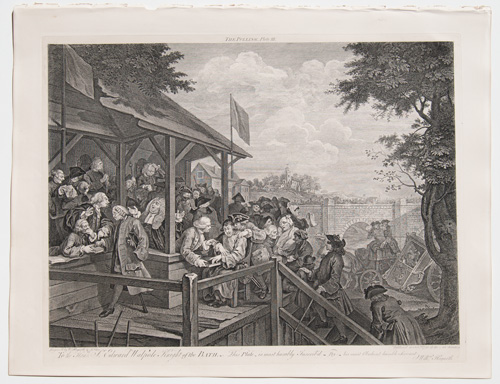
(click image to enlarge — Darvill's electronic watermark does not appear on actual engraving)
The Polling
Plate III
Painted by William Hogarth and Engraved by Wm. Hogarth and S. Cave
(Heath edition, 1822)
Sheet size: approx. 25 1/4 inches x 19 1/4 inches
Plate size: approx. 21 1/4 x 15 13/16
Condition: EXCELLENT; Nice dark impression; some foxing in margins.
[For sale in a complete set of 4 full page engravings, see below for details]
THE POLLING (PLATE III)
Burlesquing the corrupted voting process, "The Polling" depicts a scene of cynicism, confusion and trickery in which the maimed, the insane and the dying elect a member of the Parliament. A soldier who has lost three of his four limbs is first in line to take the oath. From his pocket sticks a "Milicia Bill," a bill instituting a draft to which even this helpless fellow is subject. The clerk tries to hide his crude amusement at the man's hook which rests on the Bible. On each side of him two lawyers from opposite parties argue the validity of his oath. An imbecile locked in his chair with a stick takes the oath behind the soldier; he is prompted by a fellow with a manacled leg. The letter in the prompter's pocket reading "The 6th Letter to the ...by that..." suggests he may be its author, Dr. Shebbeare, an enemy of the Hanoverians. Behind him a dying man wearing the ribbons "True Blue" is dragged up the stairs by his nurses; the first, who holds a pipe in his mouth, has lost his nose from venereal disease; the second, who laughs at the political ploy, has an oversized nose with warts on it. These are followed by a blind man guided bby his stick and a boy. A cripple follows them.
In the polling place the two candidates sit with a sleeping beadle between them. One is disconcerted, the other—presumably the one in the lead—composed. Three men enjoy a caricature of the figure beside them. Before the other candidate a group of men share a ballad with a scaffold pictured on it sold them by the old woman at the front of the balcony. Another group of men drink merrily together.
A boisterous procession crosses the bridge. Below it Britannia's coach has broken down and is about to overturn because the inattentive, cheating coachmen, like the politicians, have no concern for their duty. The tree beside the coach resembles a human face bearing a pained expression.
|
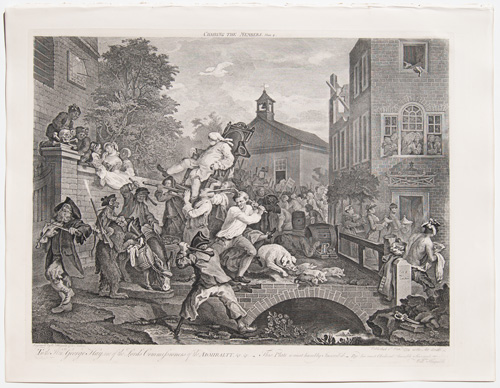
(click image to enlarge — Darvill's electronic watermark does not appear on actual engraving)
Chairing the Members
Plate IV
Painted by William Hogarth and Engraved by Wm. Hogarth and F. Aviline
(Heath edition, 1822)
Sheet size: approx. 25 1/4 inches x 19 1/4 inches
Plate size: approx. 21 5/16 x 15 13/16
Condition: Good to Very Good; Condition: EXCELLENT; Nice dark impression; some foxing in margins.
[For sale in a complete set of 4 full page engravings, see below for details]
CHAIRING THE MEMBERS (PLATE IV)
"Chairing the Members" depicts the riotous, chaotic and ignominious victory procession of the new members of Parliament. The triumphant parade of animals and men is lead by a blind, half-mad fiddler. Behind him the procession is at a halt as a bear with a monkey on its back rummages in a garbage pail carried by a grazing donkey. As the donkey's master raises a stick to club the bear, the alarmed monkey, dressed as a soldier, discharges his gun. In the path of the bullet a sweep plays prophetically with a death's head while his companion watches the procession. Next to these blackened, impoverished imps a fainting lady, perhaps a relative of the toppling politician, is revived by two servants, one of whom sees the little sweep's danger. Above the unfortunate sweep is a sundial with the words "We Must [All Die].
The bear and ape belong to a one-legged sailor who fights with a man whose club strikes one of the chairmen, causing the politician to topple into the stream. In a parallel procession a litter of pigs and their parent dash in the directino of the rivulet. Below the chair the feet of a woman who has been tossed by the animals are visible. Behind her a shrew beats her tailor husband, perhaps for not selling his vote. Two men carry a barrel of beer while another fellow, in a posture similar to the nearby pig, drains a second barrel. In the background a militant mob makes a noise with bones on meat cleavers and carries staffs and a "True Blue" flag. The shadow of the second victorious politician appears against the town hall, the façade of which is decorated with primitively designed angels.
The losing side takes refuge in a vandalized house; though new, part has been torn down and many of its windows are smashed. Before the house a half-dressed sailor takes tobacco after a fight; is broken cutlass lies behind him near a post reading "XIX Miles [from] London." Three servants bring dinner into the house. Some of those on the second floor gaze with delight on the difficulties of the victorious party; others mourn their own loss. From the top window a lawyer's parchment reading "Indintur" is visible. The lawyer may be preparing to contest the election and start the whole process over again. Of the goose flying across the sky, a poetic commentary published with Hogarth's approval says:
Minerva's sacred bird's an owl;
Our Candidate's, behold a fowl!
From which we readily suppose
(as now his generus Honour's chose)
His voice he'll in the Senate use;
And cackle, cackle, like—a goose.
The sun dial in the painting bears the date 1755 and is inscribed "Pulvis et umbra sumus" (We are dust and shadow [Horace, Odes, IV, 7]).
|
Complete set of 4 full page plates
Four Prints of an Election
Original Copperplate Engravings and Etchings from:
The Works of William Hogarth from the Original Plates Restored by James Heath, Esq., R.A.; With the Addition of Many Subjects Not Before Collected: To Which is Prefixed, a Biographical Essay on the Genius and Productions of Hogarth, and Explanations on the Subjects of the Plates by John Nichols, Esq., F.S.A.
London. Printed for Baldwin, Cradock & Joy, Paternoster Row
by Nichols and Son, Parliament Street
— 1822 —
$2795.95
(sold as a complete set of 4 full page original engravings only,
scroll down for any individual plates that may be available)
Please note: the shipping charge for these plates may need to be adjusted to account for a higher insurance value.
If necessary, we will send you a secure electronic invoice for the additional amount.
Please be sure to check your email. Thank you.
|
| |
| |
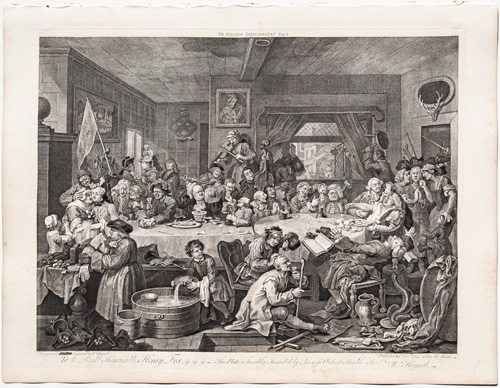
(click image to enlarge — Darvill's electronic watermark does not appear on actual engraving)
An Election Entertainment
Plate I
Painted and Engraved by William Hogarth
(Heath edition, 1822)
Sheet size: approx. 25 1/4 inches x 19 1/4 inches
Plate size: approx. 21 3/16 x 15 7/16
Condition: Excellent; Nice dark impression; some foxing in margins.
[For sale in a complete set of 4 full page engravings, see below for details]
AN ELECTION ENTERTAINMENT (PLATE I)
This crowded print depicts the drunkeness, gluttony, violence, bribery and deception that occur at an alcoholic political banquet. The feast takes place in an inn decorated with a picture of William III (slashed by the celebrating Whigs); next to it hangs a politician's coat of arms showing three guineas and the words "Speak and Have." A bellowing mouth surmounts the emblem.
At the head of the table sits one of the two Whig candidates for Parliament. His name, according to the rectangular petition being given him, is Sir Commodity Taxem. This precious beau endures with a patient smile the kiss of a fat, toothless woman whose face is pushed into his. The prankster who holds these two together burns the politician's wig with his piple. The victim puts his arm as far around the stout woman as it will go. A little girl steals the ring from his finger. The party flag "Liberty and Loyalty" hangs above them. Next to them the second politician is beset by two drunks; the first, whose face bears four scratch marks, oppresses the man with his talk and blinds him with his pipe smoke; the second plays lustfully with his hand. Behind them two men vie for a lady's favors.
Further down the table sits a prodigiously fat clergyman surrounded by food and good drink—the bottle next to him is marked "Champagne." Next to him a convivial old man has drawn the fiddler from the band by means of a drink. Behind them a Scot remonstrates with the idle musician and scratches himself. At the second table three simpleminded figures share a bottle of "Burgundy" while one of them makes faces on a kerchief. A cripple in acute but undefined distress sits next to him. At the end of the table the mayor, slumped back in his grand chair, is being bled unseccessfully; he has passed out, perhaps died, from overeating; an oyster remains on his fork.
Directly behind him an election agent attempts to bribe a Methodist tailor who stand in the pose of a saint. The tailor's wife tries to persuade him with her fist, and his son supports her by pointing to the toes which peer through his shoe. A brick has struck another election agent as he enters the names in his ledger under "Sure Votes" or "Doubtfull." His fall has overturned the table behind him and spilled food on the floor. Next to a lobster (which appears about to eat a pork chop) lie a box of pipes and some tobacco ("Kirtons Best"); the "Act against Bribery and Cor[ruption]" has, appropriately enough, been made into spills.
In the center of the foreground sit two thugs returned from battle; the broken club of one lies on the floor next to a captured Tory sign "Give us our Eleven Days." [In 1752 England adopted the Gregorian Calendar and eleven days were omitted in September.] The rough butcher (wearing the Latin dictum "Pro Patria" on his hat) pours gin into the head wound of his companion, who drinks the liqour as an anesthetic. To the amazement of the boy who fills up a tub of punch, the man's head accepts the liquid as if it were empty. An unhappy Quaker who has come to sell election insignia looks at a credit note reading "April 1 1754 I promise to Pay to Abel Squat the Sum of Fifty pounds Six m[o]nths after date Value Re[cei]ved Rich Slim." At the door a hand-to-hand combat of uncertain cause takes place.
Outside a Tory procession passes by, bearing the party platform slogans "Liberty and Property," "Marry and Multiply in Spite of the Devil" and "No Jews" on an effigy of a Jew. The Tories throw rocks in through the window. One Whig empties a chamber pot on the mob, and another prepares to throw a stool out the window.
|

(click image to enlarge — Darvill's electronic watermark does not appear on actual engraving)
Canvassing for Votes
Plate II
Painted by William Hogarth and Engraved by G. Grignion
(Heath edition, 1822)
Sheet size: approx. 25 1/4 inches x 19 1/4 inches
Plate size: approx. 21 1/8 x 15 13/16
Condition: Excellent; Nice dark impression; some foxing in margins.
[For sale in a complete set of 4 full page engravings, see below for details]
CANVASSING FOR VOTES (PLATE II)
"Canvassing for Votes" illustrates the continuing violence, deception and bribery practiced, of course, in equal measure by both parties; this time the scene is out-of-doors. On the right stands the Royal Oak; its sign depicts Charles II's head with three crowns around it; two Parliamentarian horsemen search for him. This inn, the Tory headquarters, displays a broadcloth satirizing the Whigs entitled "Punch Candidate for Guzzledown." The top part shows money pouring out of the British treasury for bribes, and depicts a coachman's head being knocked off by William Kent's impractically low arch on the Horse Guards building with its comic beer-barrel clock tower. The second part of the cloth shows the Whig candidate as Punch shoveling money indiscriminately from two bags marked "9000" and "7000."
Below Punch stands the local Tory candidate; he buys trinkets from a peddler for two girls, one coy, the other forward. At the inn door a soldier observes the attractive mistress of the house as she counts her "take"; she sits on a British lion that devours a French lily (early states show the lion with a powerful set of teeth). In the inn's bay window (which bears the mark of political violence in its broken pane) one man eats a whole bird with his hands while another fills his mouth from a steak twice his size. A porter has delivered two parcels to the candidate, one marked "Punch's Theatre, Roy[al] Oak Yar," the other "Sr Your Vote and Interest." On bended knee, the messenger offers the politician a letter addressed "To Tim Partitool Esq."
A Tory mob besieges the Whig headquarters, an inn with a crown as its sign and the words "The Excise Office" inscribed on it. One man saws off the sign, unaware that he will fall with it; two others help him bring it down with a rope tied to its support. Someone fires point blank into the crowd from a second floor window.
Outside the third inn called the "[Por]tobello" in honor of a famous British naval victory over the French, a barber and a cobbler reenact the battle. The drunken barber, whose jug, basin and cloth sit next to the table, seems to have lost a wager in the affair to his meditative opponent. In the background a quiet village rests among the hills.
|

(click image to enlarge — Darvill's electronic watermark does not appear on actual engraving)
The Polling
Plate III
Painted by William Hogarth and Engraved by Wm. Hogarth and S. Cave
(Heath edition, 1822)
Sheet size: approx. 25 1/4 inches x 19 1/4 inches
Plate size: approx. 21 1/4 x 15 13/16
Condition: Excellent; Nice dark impression; some foxing in margins.
[For sale in a complete set of 4 full page engravings, see below for details]
THE POLLING (PLATE III)
Burlesquing the corrupted voting process, "The Polling" depicts a scene of cynicism, confusion and trickery in which the maimed, the insane and the dying elect a member of the Parliament. A soldier who has lost three of his four limbs is first in line to take the oath. From his pocket sticks a "Milicia Bill," a bill instituting a draft to which even this helpless fellow is subject. The clerk tries to hide his crude amusement at the man's hook which rests on the Bible. On each side of him two lawyers from opposite parties argue the validity of his oath. An imbecile locked in his chair with a stick takes the oath behind the soldier; he is prompted by a fellow with a manacled leg. The letter in the prompter's pocket reading "The 6th Letter to the ...by that..." suggests he may be its author, Dr. Shebbeare, an enemy of the Hanoverians. Behind him a dying man wearing the ribbons "True Blue" is dragged up the stairs by his nurses; the first, who holds a pipe in his mouth, has lost his nose from venereal disease; the second, who laughs at the political ploy, has an oversized nose with warts on it. These are followed by a blind man guided bby his stick and a boy. A cripple follows them.
In the polling place the two candidates sit with a sleeping beadle between them. One is disconcerted, the other—presumably the one in the lead—composed. Three men enjoy a caricature of the figure beside them. Before the other candidate a group of men share a ballad with a scaffold pictured on it sold them by the old woman at the front of the balcony. Another group of men drink merrily together.
A boisterous procession crosses the bridge. Below it Britannia's coach has broken down and is about to overturn because the inattentive, cheating coachmen, like the politicians, have no concern for their duty. The tree beside the coach resembles a human face bearing a pained expression.
|
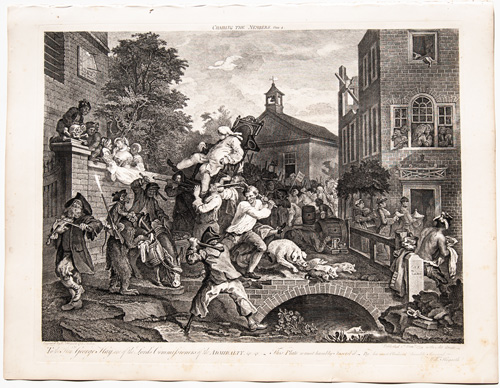
(click image to enlarge — Darvill's electronic watermark does not appear on actual engraving)
Chairing the Members
Plate IV
Painted by William Hogarth and Engraved by Wm. Hogarth and F. Aviline
(Heath edition, 1822)
Sheet size: approx. 25 1/4 inches x 19 1/4 inches
Plate size: approx. 21 5/16 x 15 13/16
Condition: Good to Very Good; Condition: Excellent; Nice dark impression; some foxing in margins.
[For sale in a complete set of 4 full page engravings, see below for details]
CHAIRING THE MEMBERS (PLATE IV)
"Chairing the Members" depicts the riotous, chaotic and ignominious victory procession of the new members of Parliament. The triumphant parade of animals and men is lead by a blind, half-mad fiddler. Behind him the procession is at a halt as a bear with a monkey on its back rummages in a garbage pail carried by a grazing donkey. As the donkey's master raises a stick to club the bear, the alarmed monkey, dressed as a soldier, discharges his gun. In the path of the bullet a sweep plays prophetically with a death's head while his companion watches the procession. Next to these blackened, impoverished imps a fainting lady, perhaps a relative of the toppling politician, is revived by two servants, one of whom sees the little sweep's danger. Above the unfortunate sweep is a sundial with the words "We Must [All Die].
The bear and ape belong to a one-legged sailor who fights with a man whose club strikes one of the chairmen, causing the politician to topple into the stream. In a parallel procession a litter of pigs and their parent dash in the directino of the rivulet. Below the chair the feet of a woman who has been tossed by the animals are visible. Behind her a shrew beats her tailor husband, perhaps for not selling his vote. Two men carry a barrel of beer while another fellow, in a posture similar to the nearby pig, drains a second barrel. In the background a militant mob makes a noise with bones on meat cleavers and carries staffs and a "True Blue" flag. The shadow of the second victorious politician appears against the town hall, the façade of which is decorated with primitively designed angels.
The losing side takes refuge in a vandalized house; though new, part has been torn down and many of its windows are smashed. Before the house a half-dressed sailor takes tobacco after a fight; is broken cutlass lies behind him near a post reading "XIX Miles [from] London." Three servants bring dinner into the house. Some of those on the second floor gaze with delight on the difficulties of the victorious party; others mourn their own loss. From the top window a lawyer's parchment reading "Indintur" is visible. The lawyer may be preparing to contest the election and start the whole process over again. Of the goose flying across the sky, a poetic commentary published with Hogarth's approval says:
Minerva's sacred bird's an owl;
Our Candidate's, behold a fowl!
From which we readily suppose
(as now his generus Honour's chose)
His voice he'll in the Senate use;
And cackle, cackle, like—a goose.
The sun dial in the painting bears the date 1755 and is inscribed "Pulvis et umbra sumus" (We are dust and shadow [Horace, Odes, IV, 7]).
|
Complete set of 4 full page plates
Four Prints of an Election
Original Copperplate Engravings and Etchings from:
The Works of William Hogarth from the Original Plates Restored by James Heath, Esq., R.A.; With the Addition of Many Subjects Not Before Collected: To Which is Prefixed, a Biographical Essay on the Genius and Productions of Hogarth, and Explanations on the Subjects of the Plates by John Nichols, Esq., F.S.A.
London. Printed for Baldwin, Cradock & Joy, Paternoster Row
by Nichols and Son, Parliament Street
— 1822 —

THIS SET HAS BEEN SOLD (TO MR. B.H.)
SEE SET ABOVE THAT IS AVAILABLE NOW
Please note: the shipping charge for these plates may need to be adjusted to account for a higher insurance value.
If necessary, we will send you a secure electronic invoice for the additional amount.
Please be sure to check your email. Thank you.
|
| |
|
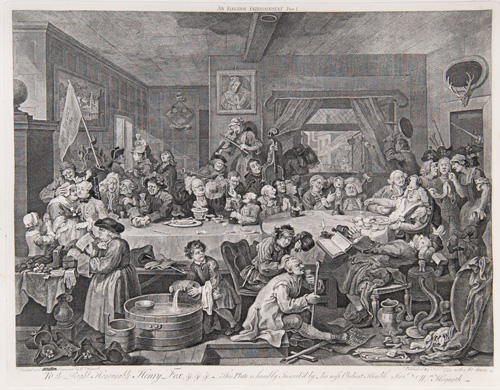
(click image to enlarge — Darvill's electronic watermark does not appear on actual engraving)
An Election Entertainment
Plate I
Painted and Engraved by William Hogarth
(Heath edition, 1822)
Sheet size: approx. 25 1/4 inches x 19 1/4 inches
Plate size: approx. 21 3/16 x 15 7/16
Condition: Excellent; Nice dark impression; minor foxing is possible in margins.
[For sale in a complete set of 4 full page engravings, see below for details]
AN ELECTION ENTERTAINMENT (PLATE I)
This crowded print depicts the drunkeness, gluttony, violence, bribery and deception that occur at an alcoholic political banquet. The feast takes place in an inn decorated with a picture of William III (slashed by the celebrating Whigs); next to it hangs a politician's coat of arms showing three guineas and the words "Speak and Have." A bellowing mouth surmounts the emblem.
At the head of the table sits one of the two Whig candidates for Parliament. His name, according to the rectangular petition being given him, is Sir Commodity Taxem. This precious beau endures with a patient smile the kiss of a fat, toothless woman whose face is pushed into his. The prankster who holds these two together burns the politician's wig with his piple. The victim puts his arm as far around the stout woman as it will go. A little girl steals the ring from his finger. The party flag "Liberty and Loyalty" hangs above them. Next to them the second politician is beset by two drunks; the first, whose face bears four scratch marks, oppresses the man with his talk and blinds him with his pipe smoke; the second plays lustfully with his hand. Behind them two men vie for a lady's favors.
Further down the table sits a prodigiously fat clergyman surrounded by food and good drink—the bottle next to him is marked "Champagne." Next to him a convivial old man has drawn the fiddler from the band by means of a drink. Behind them a Scot remonstrates with the idle musician and scratches himself. At the second table three simpleminded figures share a bottle of "Burgundy" while one of them makes faces on a kerchief. A cripple in acute but undefined distress sits next to him. At the end of the table the mayor, slumped back in his grand chair, is being bled unseccessfully; he has passed out, perhaps died, from overeating; an oyster remains on his fork.
Directly behind him an election agent attempts to bribe a Methodist tailor who stand in the pose of a saint. The tailor's wife tries to persuade him with her fist, and his son supports her by pointing to the toes which peer through his shoe. A brick has struck another election agent as he enters the names in his ledger under "Sure Votes" or "Doubtfull." His fall has overturned the table behind him and spilled food on the floor. Next to a lobster (which appears about to eat a pork chop) lie a box of pipes and some tobacco ("Kirtons Best"); the "Act against Bribery and Cor[ruption]" has, appropriately enough, been made into spills.
In the center of the foreground sit two thugs returned from battle; the broken club of one lies on the floor next to a captured Tory sign "Give us our Eleven Days." [In 1752 England adopted the Gregorian Calendar and eleven days were omitted in September.] The rough butcher (wearing the Latin dictum "Pro Patria" on his hat) pours gin into the head wound of his companion, who drinks the liqour as an anesthetic. To the amazement of the boy who fills up a tub of punch, the man's head accepts the liquid as if it were empty. An unhappy Quaker who has come to sell election insignia looks at a credit note reading "April 1 1754 I promise to Pay to Abel Squat the Sum of Fifty pounds Six m[o]nths after date Value Re[cei]ved Rich Slim." At the door a hand-to-hand combat of uncertain cause takes place.
Outside a Tory procession passes by, bearing the party platform slogans "Liberty and Property," "Marry and Multiply in Spite of the Devil" and "No Jews" on an effigy of a Jew. The Tories throw rocks in through the window. One Whig empties a chamber pot on the mob, and another prepares to throw a stool out the window.
|
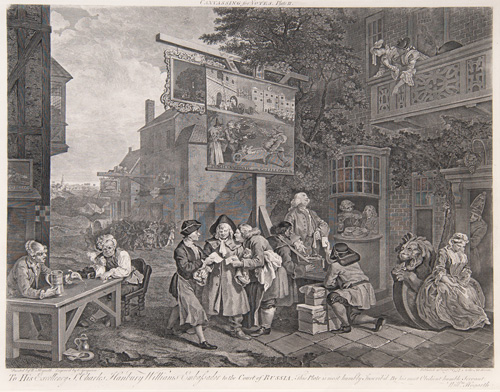
(click image to enlarge — Darvill's electronic watermark does not appear on actual engraving)
Canvassing for Votes
Plate II
Painted by William Hogarth and Engraved by G. Grignion
(Heath edition, 1822)
Sheet size: approx. 25 1/4 inches x 19 1/4 inches
Plate size: approx. 21 1/8 x 15 13/16
Condition: Excellent; Nice dark impression; minor foxing is possible in margins.
[For sale in a complete set of 4 full page engravings, see below for details]
CANVASSING FOR VOTES (PLATE II)
"Canvassing for Votes" illustrates the continuing violence, deception and bribery practiced, of course, in equal measure by both parties; this time the scene is out-of-doors. On the right stands the Royal Oak; its sign depicts Charles II's head with three crowns around it; two Parliamentarian horsemen search for him. This inn, the Tory headquarters, displays a broadcloth satirizing the Whigs entitled "Punch Candidate for Guzzledown." The top part shows money pouring out of the British treasury for bribes, and depicts a coachman's head being knocked off by William Kent's impractically low arch on the Horse Guards building with its comic beer-barrel clock tower. The second part of the cloth shows the Whig candidate as Punch shoveling money indiscriminately from two bags marked "9000" and "7000."
Below Punch stands the local Tory candidate; he buys trinkets from a peddler for two girls, one coy, the other forward. At the inn door a soldier observes the attractive mistress of the house as she counts her "take"; she sits on a British lion that devours a French lily (early states show the lion with a powerful set of teeth). In the inn's bay window (which bears the mark of political violence in its broken pane) one man eats a whole bird with his hands while another fills his mouth from a steak twice his size. A porter has delivered two parcels to the candidate, one marked "Punch's Theatre, Roy[al] Oak Yar," the other "Sr Your Vote and Interest." On bended knee, the messenger offers the politician a letter addressed "To Tim Partitool Esq."
A Tory mob besieges the Whig headquarters, an inn with a crown as its sign and the words "The Excise Office" inscribed on it. One man saws off the sign, unaware that he will fall with it; two others help him bring it down with a rope tied to its support. Someone fires point blank into the crowd from a second floor window.
Outside the third inn called the "[Por]tobello" in honor of a famous British naval victory over the French, a barber and a cobbler reenact the battle. The drunken barber, whose jug, basin and cloth sit next to the table, seems to have lost a wager in the affair to his meditative opponent. In the background a quiet village rests among the hills.
|

(click image to enlarge — Darvill's electronic watermark does not appear on actual engraving)
The Polling
Plate III
Painted by William Hogarth and Engraved by Wm. Hogarth and S. Cave
(Heath edition, 1822)
Sheet size: approx. 25 1/4 inches x 19 1/4 inches
Plate size: approx. 21 1/4 x 15 13/16
Condition: Excellent; Nice dark impression; minor foxing is possible in margins.
[For sale in a complete set of 4 full page engravings, see below for details]
THE POLLING (PLATE III)
Burlesquing the corrupted voting process, "The Polling" depicts a scene of cynicism, confusion and trickery in which the maimed, the insane and the dying elect a member of the Parliament. A soldier who has lost three of his four limbs is first in line to take the oath. From his pocket sticks a "Milicia Bill," a bill instituting a draft to which even this helpless fellow is subject. The clerk tries to hide his crude amusement at the man's hook which rests on the Bible. On each side of him two lawyers from opposite parties argue the validity of his oath. An imbecile locked in his chair with a stick takes the oath behind the soldier; he is prompted by a fellow with a manacled leg. The letter in the prompter's pocket reading "The 6th Letter to the ...by that..." suggests he may be its author, Dr. Shebbeare, an enemy of the Hanoverians. Behind him a dying man wearing the ribbons "True Blue" is dragged up the stairs by his nurses; the first, who holds a pipe in his mouth, has lost his nose from venereal disease; the second, who laughs at the political ploy, has an oversized nose with warts on it. These are followed by a blind man guided bby his stick and a boy. A cripple follows them.
In the polling place the two candidates sit with a sleeping beadle between them. One is disconcerted, the other—presumably the one in the lead—composed. Three men enjoy a caricature of the figure beside them. Before the other candidate a group of men share a ballad with a scaffold pictured on it sold them by the old woman at the front of the balcony. Another group of men drink merrily together.
A boisterous procession crosses the bridge. Below it Britannia's coach has broken down and is about to overturn because the inattentive, cheating coachmen, like the politicians, have no concern for their duty. The tree beside the coach resembles a human face bearing a pained expression.
|

(click image to enlarge — Darvill's electronic watermark does not appear on actual engraving)
Chairing the Members
Plate IV
Painted by William Hogarth and Engraved by Wm. Hogarth and F. Aviline
(Heath edition, 1822)
Sheet size: approx. 25 1/4 inches x 19 1/4 inches
Plate size: approx. 21 5/16 x 15 13/16
Condition: Good to Very Good; Nice dark impression; significant closed tear to upper left margin, extending into image. (This would not be terribly noticeable once the print has been mounted/matted/framed.
[For sale in a complete set of 4 full page engravings, see below for details]
CHAIRING THE MEMBERS (PLATE IV)
"Chairing the Members" depicts the riotous, chaotic and ignominious victory procession of the new members of Parliament. The triumphant parade of animals and men is lead by a blind, half-mad fiddler. Behind him the procession is at a halt as a bear with a monkey on its back rummages in a garbage pail carried by a grazing donkey. As the donkey's master raises a stick to club the bear, the alarmed monkey, dressed as a soldier, discharges his gun. In the path of the bullet a sweep plays prophetically with a death's head while his companion watches the procession. Next to these blackened, impoverished imps a fainting lady, perhaps a relative of the toppling politician, is revived by two servants, one of whom sees the little sweep's danger. Above the unfortunate sweep is a sundial with the words "We Must [All Die].
The bear and ape belong to a one-legged sailor who fights with a man whose club strikes one of the chairmen, causing the politician to topple into the stream. In a parallel procession a litter of pigs and their parent dash in the directino of the rivulet. Below the chair the feet of a woman who has been tossed by the animals are visible. Behind her a shrew beats her tailor husband, perhaps for not selling his vote. Two men carry a barrel of beer while another fellow, in a posture similar to the nearby pig, drains a second barrel. In the background a militant mob makes a noise with bones on meat cleavers and carries staffs and a "True Blue" flag. The shadow of the second victorious politician appears against the town hall, the façade of which is decorated with primitively designed angels.
The losing side takes refuge in a vandalized house; though new, part has been torn down and many of its windows are smashed. Before the house a half-dressed sailor takes tobacco after a fight; is broken cutlass lies behind him near a post reading "XIX Miles [from] London." Three servants bring dinner into the house. Some of those on the second floor gaze with delight on the difficulties of the victorious party; others mourn their own loss. From the top window a lawyer's parchment reading "Indintur" is visible. The lawyer may be preparing to contest the election and start the whole process over again. Of the goose flying across the sky, a poetic commentary published with Hogarth's approval says:
Minerva's sacred bird's an owl;
Our Candidate's, behold a fowl!
From which we readily suppose
(as now his generus Honour's chose)
His voice he'll in the Senate use;
And cackle, cackle, like—a goose.
The sun dial in the painting bears the date 1755 and is inscribed "Pulvis et umbra sumus" (We are dust and shadow [Horace, Odes, IV, 7]).
|
Complete set of 4 full page plates
Four Prints of an Election
Original Copperplate Engravings and Etchings from:
The Works of William Hogarth from the Original Plates Restored by James Heath, Esq., R.A.; With the Addition of Many Subjects Not Before Collected: To Which is Prefixed, a Biographical Essay on the Genius and Productions of Hogarth, and Explanations on the Subjects of the Plates by John Nichols, Esq., F.S.A.
London. Printed for Baldwin, Cradock & Joy, Paternoster Row
by Nichols and Son, Parliament Street
— 1822 —

(To Mrs S. F.)
(sold as a complete set of 4 full page original engravings only,
scroll down for any individual plates that may be available)
Please note: the shipping charge for these plates may need to be adjusted to account for a higher insurance value.
If necessary, we will send you a secure electronic invoice for the additional amount.
Please be sure to check your email. Thank you.
|
|
| INDIVIDUAL PLATES AVAILABLE FROM FOUR PRINTS OF AN ELECTION |
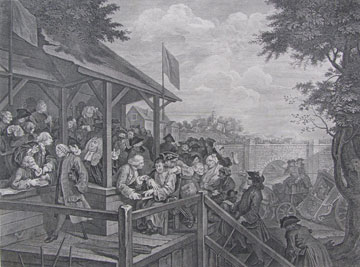
(click image for enlargement)
FROM "FOUR PRINTS OF AN ELECTION"
"The Polling, plate 3"
Painted by William Hogarth, engraved by Hogarth and La Cave
Edition: Heath (1822) published for Baldwin, Cradock & Joy, London
Size: approx. 25¼ x 19¼ inches
Condition issues: light foxing and small nicks to extreme edges.
Otherwise very good condition
Price: $275

|
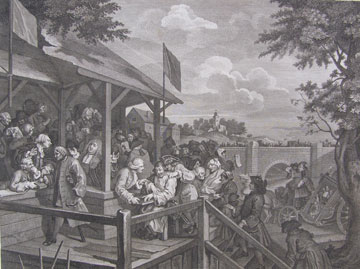
(click image for enlargement)
FROM "FOUR PRINTS OF AN ELECTION"
"The Polling, plate 3"
Painted by William Hogarth, engraved by Thomas Cook
Edition: Cook (1796-1803)
Size: approx. 23¾ x 17¼ inches
Condition issues: extremely narrow bottom margin, nicks and
small tears in margins, well outside plate area.
Price: $350

|
| |
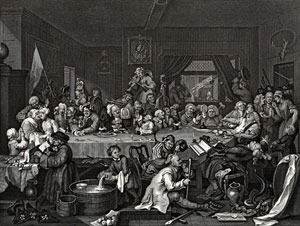
(click image to enlarge)
The Election
Plate 1
Humours of an Election Entertainment
"The Complete Works of William Hogarth"
(Mackenzie, London, 1870)
Sheet size: 8 3/4 x 12 1/4 inches
engraving on steel
Condition: Very good—mild grubiness to outer margins
(note: entire sheet is too large to scan)
$149.95
|
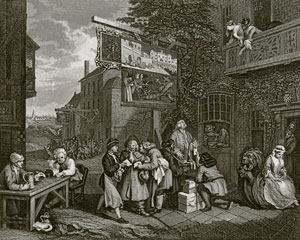
(click image to enlarge)
The Election
Plate 2
Canvassing for Votes
"The Complete Works of William Hogarth"
(Mackenzie, London, 1870)
Sheet size: 8 3/4 x 12 1/4 inches
engraving on steel
Condition: Excellent
(note: entire sheet is too large to scan)

|
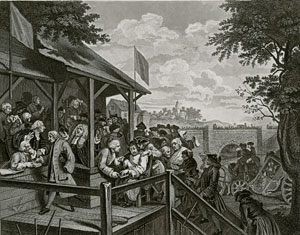
(click image to enlarge)
The Election
Plate 3
The Polling
"The Complete Works of William Hogarth"
(Mackenzie, London, 1870)
Sheet size: 8 3/4 x 12 1/4 inches
engraving on steel
Condition: Excellent
(note: entire sheet is too large to scan)
$119.95
|
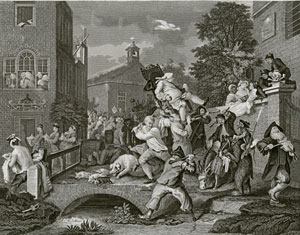
(click image to enlarge)
The Election
Plate 4
Chairing the Member
"The Complete Works of William Hogarth"
(Mackenzie, London, 1870)
Sheet size: 8 3/4 x 12 1/4 inches
engraving on steel
Condition: Excellent
(note: entire sheet is too large to scan)

|
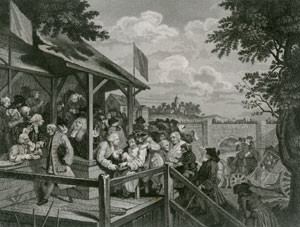
(click image to enlarge)
The Election
Plate 3
The Polling
unidentified publication — 19th century
(Jones & Co Temple of the Muses, Finsbury Square, London)
Sheet size: 8 x 10 1/2 inches
engraving on steel
Condition: Poor/Fair — damp stains and foxing in margins mainly
(note: entire sheet is too large to scan)
$49.95
|
|
An Election Entertainment
[plate 1]
by William Hogarth
LOCATION OF ORIGINAL (IN 1903):
Soane Museum, London
Approximate image size: 13.5 x 10.5 inches
Sheet size: approx. 15 x 20 inches
Original photogravure (photo-engraving)
from Great Masters 1400-1800
(London, 1903)
|
$119.95 |
|
"The Works of William Hogarth" by Rev. John Trusler
published by Jones and Co, London (1833)
|
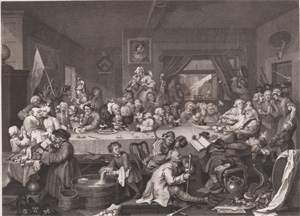
(click image to enlarge)
The Election
Plate 1
An Election Entertainment
"The Works of William Hogarth
in a Series of Engravings: with descriptions and a
Comment on Their Moral Tendency
by the Rev. John Trusler"
(Jones and Co., Temple of the Muses, (Late Lackington's), Finsbury Square, London, 1833)
Original 180+-year-old copperplate engraving
Sheet size: 8 1/4 x 10 1/2 inches
original text accompanies engraving
Condition: Fair, with some foxing. Please refer to detailed scan by clicking on thumbnail image provided.
SOLD AS A COMPLETE SET OF 4, SEE BELOW |
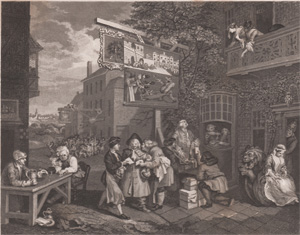
(click image to enlarge)
The Election
Plate 2
Canvassing for Votes
"The Works of William Hogarth
in a Series of Engravings: with descriptions and a
Comment on Their Moral Tendency
by the Rev. John Trusler"
(Jones and Co., Temple of the Muses, (Late Lackington's), Finsbury Square, London, 1833)
Original 180+-year-old copperplate engraving
Sheet size: 8 1/4 x 10 1/2 inches
original text accompanies engraving
Condition: Fair, with some foxing. Please refer to detailed scan by clicking on thumbnail image provided.
SOLD AS A COMPLETE SET OF 4, SEE BELOW |
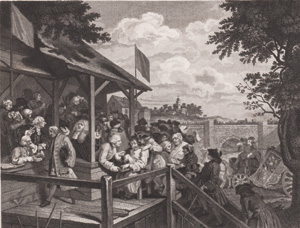
(click image to enlarge)
The Election
Plate 3
The Polling
"The Works of William Hogarth
in a Series of Engravings: with descriptions and a
Comment on Their Moral Tendency
by the Rev. John Trusler"
(Jones and Co., Temple of the Muses, (Late Lackington's), Finsbury Square, London, 1833)
Original 180+-year-old copperplate engraving
Sheet size: 8 1/4 x 10 1/2 inches
original text accompanies engraving
Condition: Excellent. Please refer to detailed scan by clicking on thumbnail image provided.
SOLD AS A COMPLETE SET OF 4, SEE BELOW |

(click image to enlarge)
The Election
Plate 4
Chairing the Member
"The Works of William Hogarth
in a Series of Engravings: with descriptions and a
Comment on Their Moral Tendency
by the Rev. John Trusler"
(Jones and Co., Temple of the Muses, (Late Lackington's), Finsbury Square, London, 1833)
Original 180+-year-old copperplate engraving
Sheet size: 8 1/4 x 10 1/2 inches
original text accompanies engraving
Condition: Good, some foxing. Please refer to detailed scan by clicking on thumbnail image provided.
SOLD AS A COMPLETE SET OF 4, SEE BELOW |
COMPLETE SET OF FOUR ORIGINAL COPPERPLATE ENGRAVINGS
"THE ELECTION"
(Trusler, 1833)
$349.95
|
|